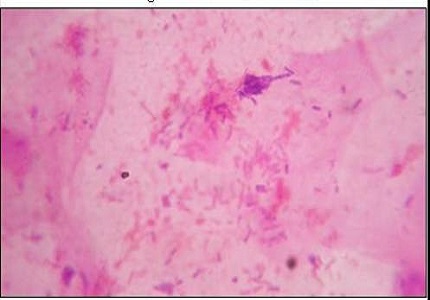Prevalence and diagnosis of bacterial Vaginosis in tertiary care teaching hospital
Abstract
Introduction: Bacterial vaginosis is the most common cause of vaginal discharge among women in reproductive age. The normal flora of the vagina varies from person to person, but lactobacilli are usually the preponderant organism. Bacterial flora also contains other aerobic and anaerobic microorganisms. Some of these are considered to be pathogenic. It is recognized that, bacterial vaginosis may be associated with pelvic inflammatory disease, preterm premature rupture of the membranes (PROM), post operative gynaecologic infections and abnormal Papanicolaou smear.
Objective: 1) to find the prevalence of bacterial vaginosis. 2). To find the most cost effective reliable method for diagnosis of bacterial vaginosis.
Method: A total of 360 consecutive women with complaints of vaginal discharge were considered for the study. The study was undertaken from January 2015 till June 2016 at KBN medical college and hospital, Gulbarga, Karnataka. BV was diagnosed based on Amsel’s composite criteria and Nugent’s scoring system. pH was determined, Whiff amine test for the presence of fishy odor and the presence of the clue cells on vaginal smear were observed. Gram staining was performed for Nugent’s method.
Result: Prevalence of BV was 44.16%. Most common affected age group was between 24-35 years. Routinely a combination of various methods are used for the diagnosis of bacterial vaginosis (BV), although nugent criterion is considered as the gold standard method The prevalence rate of BV in present study was high.
Conclusion: With limited resources in developing countries, there is a great need for inexpensive diagnostic methods for bacterial vaginosis. Amsel’s criteria is as good as Nugent’s scoring in diagnosis of BV and it is simple, easy, cost effective, fast and reliable, and can be done in OPD which can be used for precise and fast treatment.
Downloads
References
2. International Institute for Population Sciences (IIPS) and ORC Macro. 2000. National Family Health Survey (NFHS-2), Mumbai, India; 1998– 99: 307-360.
3. Sobel JD. Bacterial vaginosis. Annu Rev Med. 2000;51:349-56. [PubMed]
4. Hillier SL,krohn MA,Klebanoff SJ,Eschenback DA. The relation ship of hydrogen peroxide producing lactobacilli to bacterial vaginosis and genital microflora in pregnant women .Obstet Gynecol 1992 Mar ;79 (3):369-73.
5. Henry MR. The Bethesda System 2001: an update of new terminology for gynecologic cytology. Clin Lab Med. 2003 Sep;23(3):585-603. [PubMed]
6. Leitich H, Bodner-Adler B, Brunbauer M, Kaider A, Egarter C, Husslein P. Bacterial vaginosis as a risk factor for preterm delivery: a meta-analysis. Am J Obstet Gynecol. 2003 Jul;189(1):139-47. [PubMed]
7. Amsel R, Totten PA, Spiegel CA, Chen KC, Eschenbach D, Holmes KK. Nonspecific vaginitis. Diagnostic criteria and microbial and epidemiologic associations. Am J Med. 1983 Jan;74(1):14-22.
8. Nugent RP, Krohn MA ,Hillier SL. Reliability of diagnosing bacterila vaginosis is improved by a standardised method of gram stain interpretation . J Clin Microbiol. 1991 Feb;29(2):297-301.
9. Langsford MJ, Dobbs FF , Morrison GM, Dance DA. The effect of introduction of a guideline on the management of vaginal discharge and in particular bacterial vaginosis in primary care. Fam Pract 2001 june;18(3):253-7.
10. Laxmi U, Bhat G, Kotigadde S, Shenoy S. Comparison of the Methods of Diagnosis of Bacterial Vaginosis. Journal of Clinical and Diagnostic Research. 2011 June; 5(3):498-501.
11. Eschenbach DA, Hillier S, Critchlow C, Stevens C, derouen T, Holmes KK. Diagnosis and clinical manifestations of bacterial vaginosis. Am J Obstet Gynecol. 1988 Apr;158(4):819-28.
12. Yoshimura K, Morotomi N, Fukuda K, et al. Intravaginal microbial flora by the 16S rrna gene sequencing. Am J Obstet Gynecol 2011; 205: 235.e1-9. [PubMed]
13. Nawani M , Sujatha R. Diagnosis And Prevalence Of Bacterial Vaginosis In A Teritiary Care Centre At Kanpur. JEMDS 2013 June; 2(22): 3959– 62.
14. Tiyyagura S, Taranikanti M, Ala S, Mathur DR. Bacterial Vaginosis in Indian Women in the Reproductive Age Group. Int J of Biomed Res. 2012; 3(8) 371–373.
15. Rajeshwar Rao S, Pindi KG, Rani U,Sasikala G,Kawle V. Diagnosis of Bacterial Vaginosis :Amsel’s criteria vs Nugent’s scoring. Sch. J. App. Med. Sci. 2016 June; 4(6C):2027-2031.
16. Thulkar J, Kriplani A, Agarwal N, Vishnubhatla S. Aetiology & risk factors of recurrent vaginitis & its association with various contraceptive methods. Indian J Med Res. 2010 Jan;131: 83-87.
17. Blackwell A , Barlow D. Clinical Diagnosis Of Anaerobic Vaginosis(non specific vaginitis )- A practical guide. Br J Vener Dis. 1982 Dec;58(6): 387-93.
18. Schnadig VS, Davie KD, Shafer SK, Yandell RB, Islam MZ, Hannigan EV. The cytologist and bacterioses of the Vaginal – ectocervical area clues, commas and confusion. Acta Cytol 1989;33(3):287-97. [PubMed]
19. Grataco AE, Figueras F, Barranco M, Ros R, Andreu AA, Pedro L et al.; Prevalence of bacterial vaginosis and correlation of clinical to Gram stain diagnostic criteria in low risk pregnant women. Eur J Epidemiol. 1999; 15: 913-6.
20. Brand JM, Galask RP. Trimethylamine: the substance mainly responsible for the fishy odor often associated with bacterial vaginosis. Obstet Gynecol. 1986 Nov;68(5):682-5. [PubMed]
21. Goyal R, Sharma P, Kour I, Aggarwal N, Talwar V. Diagnosis of Bacterial Vaginosis in Women in Labour, jk sciences. 2005; Jan7(1):1-4.
22. Schwebke JR, Hillier SL, Sobel JD, mcgregor JA, Sweet RL. Validity of the vaginal gram stain for the diagnosis of bacterial vaginosis. Obstet Gynecol. 1996 Oct;88(4 Pt 1):573-6.
23. Forsum U, Jakobsson T, Larsson PG et al. An international study of the interobserver variation between interpretations of vaginal smear criteria of bacterial vaginosis. APMIS.2002 Nov; 110(11): 811–18.
24. Larsson PG, Carlsson B, Fåhraeus L, Jakobsson T, and Forsum U. Diagnosis of bacterial vaginosis: need for validation of microscopic image area used for scoring bacterial morphotypes. Sex Transm Infect. 2004 Feb; 80(1): 63–67.
25. Thomason JL, Gelbart SM, Anderson RJ, Walt AK, Osypowski PJ, Broekhuizen FF. Statistical evaluation of diagnostic criteria for bacterial vaginosis. Am J Obstet Gynecol. 1990 Jan;162(1):155-60. [PubMed]



 OAI - Open Archives Initiative
OAI - Open Archives Initiative


